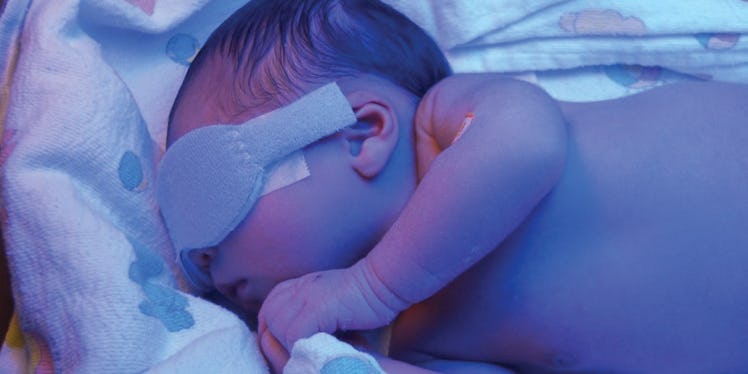How To Recognize And Treat Jaundice In Your Baby
It's not a good thing, Chris Martin.

Without yellow, the sun would look weird. The Beatles would have to live in a less brightly colored submarine. Also, that dude from Coldplay would never have written any songs for you. Two of those things are sad.
Yes, there are many circumstances where you might want yellow. But there are many other instances where you don’t want yellow. They include: on your baby and in anemic ear-wormy pop songs. Luckily you can do something about the first one — and it doesn’t even require a time machine or the ability to teach Chris Martin an actually useful profession.
Jaundice, Baby
Infant jaundice diagnosis links to a yellow tint in your baby’s eyes. That yellow color may also be present on the face and chest. It is caused by a compound in red blood cells called bilirubin, which is usually broken down by the liver. A helpful mnemonic to remember how this works is to think of the liver as Angelina Jolie desperately trying to rid herself of Bilirubin-Bob Thornton.
flickr / George Keith
Why It Happens
Infant jaundice is incredibly common, particularly among preterm and breastfed babies. It is so common, in fact, that doctors routinely screen newborns for jaundice until they’re discharge from the birth center or hospital. However, bilirubin levels generally peak at three days after birth, so if you were discharged early, make sure you (or better yet, a professional) gets eyes on your kid.
An immature liver causes increased levels of bilirubin (or hyperbilirubinemia if you’re not into the whole brevity thing) in infants. Interestingly, immature liver also wreak havoc at any party thrown by high schoolers.
Nursing mothers may also have babies prone to infant jaundice. Usually this is linked to nursing issues that leave the kid dehydrated or malnourished.
flickr / Dave Herholz
The Fix
If your doc diagnoses your baby with jaundice there will be a couple of common treatments they might recommend. They tend to work really well.
- Light Therapy: Many babies with jaundice will benefit from specialized UV light that can penetrate the skin and help break down bilirubin. Bonus: you don’t need a night light.
- More Nursing: The doc will recommend more frequent breastfeeding from your partner if poor nursing caused the jaundice. They might also recommend supplemental feeding with pumped milk or formula.
The lesson here is to keep an eye on your kid’s skin and eyes for the first few days. Ring the doc if anything looks abnormal. With the right treatment, their skin and bones will turn into something beautiful, instead of being all yellow.
This article was originally published on